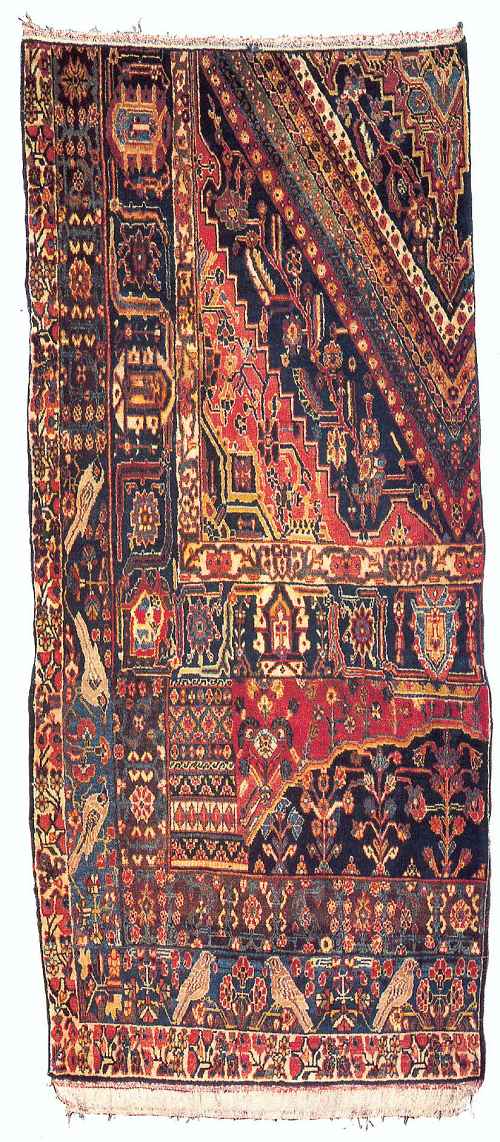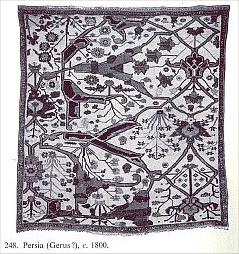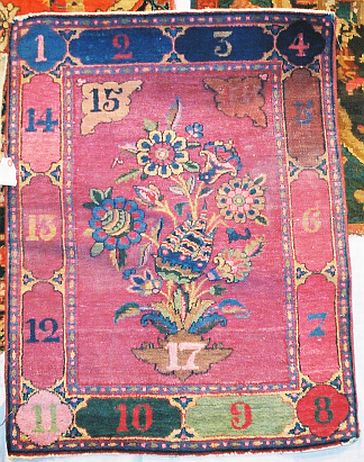
The Salon du Tapis d'Orient is a moderated discussion group in the manner of the 19th century salon devoted to oriental rugs and textiles and all aspects of their appreciation. Please include your full name and e-mail address in your posting.
by R. John Howe and Filiberto Boncompagni
Page 2
“The wagireh, that is the knotted pattern, has probably been used for centuries. Skilled weavers produce a small carpet from a design on graph paper, and this serves for years as a durable pattern whereas the paper patterns soon disintegrate. The weaver counts the knots on the back of the wagireh and uses the same number in his carpet. It is possible that the origin of the wagirehs lies in the distant past and that the designer who created the pattern and knotted the wagireh in this way perpetuated his ideas among weavers for a long period. Nomads still use vagirehs and so do villagers in Central Asia.”

Taher Sabahi’s “VAGHIREH”, Qashqai Kashkuli page 86-87
Forty years ago weavers in the Sultanabad and Hammadan districts worked almost exclusively from such models. Wagirehs, commonly used by women, give the weaver a chance to use their initiative. Patterns are often employed in which neither the measurements nor the colors agree with the carpet as ordered. It is left to the skill of the weavers to make the necessary adjustments.It is also always useful to consult Cecil Edwards in “The Persian Carpet.” In a first passage he says,
“The introduction of the ‘wagireh’ system---whereby a mat was woven with one repeat of the design and was used as a pattern by the weaver---enabled the merchants to distribute the better designs more widely. The more recent introduction of scale-paper patterns has still further simplified the system.”

And later:
“…It was (ed. Zieglers, in 1883) who established the system of giving out the yarn ready dyed to the weavers. They used both native and European dyes. Their designs were mostly repeating patterns... The repeat was first woven in the form of mats---twenty or more mats of a pattern---which were distributed among the weavers to be used for models for their carpets. In course of time these mats or wagirehs were replaced by scale-paper designs which are now used exclusively in the town and villages alike…”

Sotheby's
Auctions The Oak and Country Sale 27
Sep 2001 A Ziegler Mahal wagireh, Central Persia,
circa 1900, 112 by 108 cm., 3 ft. 8 in. by 3 ft. 7 in.
Harold had brought a copy of what seems to be the only book devoted to “vaghirehs.” (It has that title and was written by Taher Sabahi, the owner publisher of “Gereh,” the Italian rug magazine and was published in Italian only.

Sabahi sides with those who feel that the wagireh has a longer history.
Digest of what Sabahi writes:
To begin with, we have to distinguish between a proper
Vaghierh and a sampler – the second is a model for a carpet on a smaller scale.
First - Vaghirehs were for weavers’ personal use, to
transmit old motifs or also made by master weavers for selling to less skilled
ones. Used in areas of small, rustic output. This kind is rare because seldom
it came out from its “territory”. It presented generally several examples of
borders with one filler motif, suitable for only one “model” of rug.
Second - Small workshops started to use them as samplers
for promotion (from small workshop to big customers like Ziegler). They were more
complex, presenting a wider variety of designs suitable for different “models”
of rugs.
Third, they could be just a “study” made by master
weavers to experiment new designs. They were generally very small with only one
motif repeated in different scales and colors.
Then, the Ziegler(s) and similar organizations found that Vaghirehs were good means to disseminate new designs to village manufacturing which wouldn’t be familiar with the more sophisticate (but also more restraining for creativity) cartoons or graph-paper loom-drawings.
So you can see that the rug literature gives mixed
signals. A number of writers see the
wagireh as something associated with the establishment in the later part of the
19th century of European rug weaving operations in Iran and
Turkey. But at least Hildebrand argues
that wagirehs have been made for “centuries” and “were still woven by nomads”
in his time.
We have what we might call a “historical argument” on one
hand and a “logical” one on the other about how recently a phenomenon the
wagireh is likely to be.
A “historical” case would be best if we can make it. How old are most of the wagirehs that we have estimated to be? How frequent are wagirehs dating to the early 19th or late 18th centuries? How old is the wagireh with the oldest estimated date that we can discover in this conversation? How widespread does the use of wagirehs seem to have been? Do we have examples from tribal and nomadic groups? Do weavers today still weave wagirehs and for what purposes?
Taking these questions one at a time, most of the wagirehs
we have seem to come from the late 19th century or the earliest 20th
century.

Harold Keshishian’s rug morning, Malayer, 1900
We do not frequently encounter wagirehs estimated to have been woven in the early 19th century or earlier but there are some examples.


T. Sabahi’s “VAGHIREH”, Gaenat, Persia, end of 17th (Savafid Period) cm.70x30, Page 88-89
Most of the wagirehs we have do seem to have been woven in the NW Persian areas where the Europeans had their weaving operations BUT there are wagirehs from most weaving areas.

T. Sabahi’s “VAGHIREH”, Ushak, 19th cm. 225x117, page 36

T. Sabahi’s “VAGHIREH”,
Kirsheir, end 19th cm.155x86, page 48-49

T. Sabahi’s “VAGHIREH”, Kirsheir, middle19th, cm. 94x55, page 50-51

T. Sabahi’s “VAGHIREH”, Karabagh, second half 19th, cm 133x78, page 90-91

Sotheby’s Sale N08103, New York 03 Jun 05 SEYCHOUR WAGIREH 6ft. 5in. by 3ft. 10in. 1.96 by 1.17m) circa 1880

Sotheby’s Sale L03760, London 30 Apr 03 SEYCHOUR WAGIREH 161 by 126cm., 5ft. 4in. by 4ft. 2in. late 19th century

T. Sabahi’s “VAGHIREH”, Bakhtiari, beginning 20th, cm.170x120, page 80-81

T. Sabahi’s “VAGHIREH”, Quashqai Khordjin, end 19th , cm. 60x64. page 84-85

Harold Keshishian’s rug morning, brought in and owned by Gordon Priest. South Persian. 1910-20. Afshiri-Shiraz.
Turkmen:

T. Sabahi’s “VAGHIREH”,
Beshir, 19th, cm.55x72, page 92-93

Ersari, early 20th, 46 x 42 cm / 1'6" x 1'5" (from Cloudband)
India:

Harold Keshishian’s rug morning, Indian wagireh, 1900
Note: Sabahi says that Indians used them as samplers, also for flatweaves (dhurries): manufacturers sent them to customers. The customers chose borders and field motifs by pinning pins on them and sent the samplers back. Manufacturers often used the work of detainees.